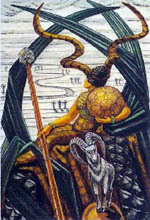(This post is part of a series describing implementation of the hacks in O’Reilly’s Mind Performance Hacks book. You may want to refer to the first post in this series, or the post describing my setup for Mind Performance Hack #1.)
It’s been nearly a month since I started implementing MPH #1’s suggestion of using a memory peg system to ensure I don’t forget anything important when I leave the house in the morning; I’d say that this is enough time to draw some conclusions about the efficacy of the technique.
My implementation of this hack has been rigorous: every morning before leaving I have quickly stepped through the mental list, usually placing each item in my pocket or bag as I think of its peg. I have not forgotten any item on the list during this past month. In fact, this morning I thought I had left my catch on the kitchen table, but I discovered that I had automatically placed it in my coat pocket as I went through the list. Using this hack hasn’t necessarily made me less absent-minded, but at least I’m putting my robotic trance to good use.
I have extended my original peg list with three additional entries:
- Ten is ‘hen’: wildcard. I often have some item that’s not on my regular list that I nonetheless have to remember to take with me: a deposit to take to the bank, a letter to mail, quarters for the parking meters, and so on. M—— not infrequently has been exasperated as I’ve failed to take some item that she’s left where I’ll be sure to notice it (on top of the key box, say, or hanging from the door knob) . . . I’ll happily move whatever it is aside and never have a conscious thought about it.
Usually, it’s enough to remember that there’s something else that I have to bring . . . like a string tied around the finger. I try to give myself a hint, though, with a multilevel peg. For this image, I picture a hen pecking at the key box on top of the microwave. Suddenly, the box flies open like Pandora’s box, and the hen flaps off squawking in a flurry of feathers and swirling Technicolor troubles. All that is left behind in the box is the joker from a deck of playing cards . . . a wild card. If there’s something else I need to remember, I’ll associate it with the joker using the same mnemonic techniques.
- Eleven is ‘leaven’: Kleenex. (I couldn’t come up with a good noun, so I went with a verb.) I picture myself kneading bread dough. I add Kleenex, and they adhere to the sticky mass.
- Twelve is ‘shelve’: USB thumbdrive. (Another verb, it seems . . . it was this or ‘delve’.) I imagine driving a bookshelf down the street. The front end is a giant USB connector.
 My pegs are pretty much filled up, though. One could perhaps add “thirteen is ‘dirt queen'”, using, say, an image of the Queen of Discs from Crowley’s Tarot, and “fourteen is ‘floor sheen'”, but I admit my my invention has been failing me on a rhyming peg for “fifteen”.
My pegs are pretty much filled up, though. One could perhaps add “thirteen is ‘dirt queen'”, using, say, an image of the Queen of Discs from Crowley’s Tarot, and “fourteen is ‘floor sheen'”, but I admit my my invention has been failing me on a rhyming peg for “fifteen”.
Extending this further would probably be best done with a different memory system. I did manage to get extra mileage out of some of the pegs by stacking several items into one image (both cellphone and headset for number three, for example, and my Hipster, Moleskine, and a pen for number six). Some of my images (such as the cartoonish St. Peter for number seven) are rather spare, and there’s probably room to hang additional items on the peg.
In general, I am satisfied with the results of this experiment. I would judge this hack to be quite effective at its modest goals, and would further observer that it’s a good introduction to the principles of basic mnemotechnics. I’ll be continuing to use this system for the foreseeable future.
